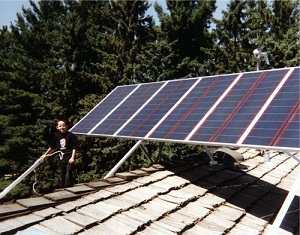Minnesota could go 100% renewable for about 2 cents per kWh
 The land of 10,000 lakes could go 100 percent renewable, driven by solar, wind, and compressed air storage, and with the right energy efficiency improvements, policies and infrastructures it would only add about 1 to 2 cents per kilowatt hour (kWh) to consumers‘ electric bills. That’s according to a new report from Institute for Energy and Environmental Research (IEER).
The land of 10,000 lakes could go 100 percent renewable, driven by solar, wind, and compressed air storage, and with the right energy efficiency improvements, policies and infrastructures it would only add about 1 to 2 cents per kilowatt hour (kWh) to consumers‘ electric bills. That’s according to a new report from Institute for Energy and Environmental Research (IEER).
The report came about after one of the authors, Dr. Arjun Makhijani, was asked to testify before the state’s joint energy commission in 2009. He was testifying against repealing a Minnesota law that prohibited more nuclear plants from being built in the state. Some wanted nuclear power in the state as a means to reduce Minnesota’s greenhouse gas emissions, Makhijani offered an alternative scenario, according to co-author Christina Mills. The report came out of the interest the testimony generated.
“There was no formal request from the state. We undertook it independently based on conversations and informal questions from legislators and non-profits,” Mills said.
The report determined that to make the state 100 percent renewable, the state would have to add in 12.3 gigawatts of wind energy and 4.6 gigawatts of rooftop solar.
That’s equivalent to Xcel Energy’s, the state’s largest utility, hourly sales in 2007.
However, to get there, wind and solar must be combined with storage capabilities, most likely compressed air and pumped hydro. It would also take using existing hydropower and an increase in-state small hydropower and biomass-based power, according to Mills.
The report focused on rooftop solar because Minnesota is such an agricultural state, according to Mills.
“So much of the state is devoted to agriculture. It doesn’t make a good argument to take agricultural land out of production,” she said.
The legislators and non-profits are still interested in the research.
“At our press release I was impressed by attendance from legislators,” Mills said.
That’s at least partly because of Minnesota’s plans to reduce its environmental impact, by reducing emissions and add in more renewables.
“This is a first step to unify all those goals and show what that looks like,” said Mills.
The next step is to start talking with other environmental groups and to develop a small pilot project, according to Mills.
“Like a campus that could model what this kind of smart microgrid would look like,” she said.
The next level will also likely include working with Xcel to better understand how businesses impact the grid.



